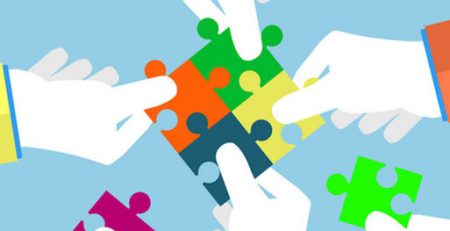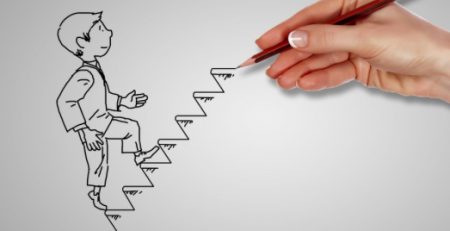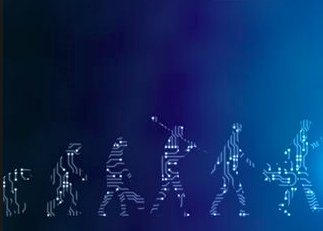Learning How To Change Part 2
Written by: Cahide Akkuzu
Reading time: 6 minutes
In this series of articles, I propose to look at change not as a challenge we must manage, but as a process that we can consciously approach so that it helps us to learn how to change. Change is a 3-step transition process people go through as they internalize and come to terms with their new situation. It’s a journey from one identity to another, which William Bridges divides into three stages: Endings, Neutral Zone, and Beginnings. In Part 1 of this article we looked into the ‘Endings’ stage which involves processing our losses. To read the article click: https://www.contextprofessionals.com/en/learning-how-to-change-part-1/
In this article, we will look at the second stage of the process, the “Neutral Zone”. William Bridges defines the neutral zone as the time between an ending of the old and the beginning of the new. It’s the liminal space, like a state of limbo, where there’s nothing to hold onto because what was old and familiar is now gone and what is new has not yet fully taken form. It’s the stage in which a caterpillar transforms into a butterfly or it’ s the tunnel between one destination and the next. The neutral zone is not a comfortable place to be at, it involves to stay in uncertainty. Whereas, we human beings like certainty. Therefore it’s common to feel the urge to rush through this feeling of uncertainty, but it’s important to resist that urge. The neutral zone is a very important time to process the past and lay the groundwork for what’s to come. This is the time for questioning, growth, learning from the past, forming plans for the future, courage, creativity, and risk-taking.
We must give ourselves enough time in this neutral zone. Rushing through this stage without giving yourself the time to properly process can result in decisions that you may later regret. Though uncomfortable, this is a necessary period to confront ourselves with what we have to process before we can move forward.
The only way out is through. – Robert Frost
As you face the challenges of uncertainty while in the neutral zone, you can go through powerful emotions such as anger, grief, denial, resentment, and sadness. Instead of suppressing these feelings, spend time digesting and giving yourself time to process these feelings, as Robert Frost says, go ‘through’ these feelings. Here are a few suggestions that you can use:
- Accept that you are in the neutral zone and that this is an in-between period for the transition from one identity to another. Shift your mindset to one that values this in-between space. Bring your mind back from wallowing in the past or speeding up into the future. Resist your urge to rush through this period. Avoid premature decisions. Nothing is permanent, this period will end when the time comes!
- Re-adjust your expectations about your own level of productivity. You are in an in-between period and like a seed germinating below the surface, the self- work that you are currently doing now might not be as outwardly visible as you have come to expect from yourself.
- Completely suspend, or at least limit as much as possible all other major changes in your life during this period.
- Try new things out. Use your creativity during this period. Discover new things, visit new places, learn new things, or take a course. Do something new outside of your normal.
- During this period, set yourself short-term goals and focus on achieving them. This will make you feel anchored in this ambiguous time.
- Allow your emotional experience to unfold, even if it takes you to some uncomfortable places. Be aware of and accept your emotions such as anger, resentment, or worry, and do not try to push them away or change them. What do these emotional experiences want to draw your attention to? What is your unmet need? Reflect on your experience through journaling or seek out support from your community.
- Above all, treat yourself the way you treat your best friend during this period! With understanding and compassion!
As much as we would like to imagine ourselves going through this neutral zone period with self-compassion and poise, we’re only human, and we are going to encounter some challenges along the way to our next new beginning. We will in some way and to a certain degree resist change. Resistance is the opposite of acceptance. When you’re resisting something that’s already happened or you have no power to stop from happening, it can make you feel stuck and hold you back from moving forward.
It is not the strongest of the species that survives, nor the most intelligent that survives. It is the one that is most adaptable to change. – Charles Darwin
Your resistance to change may emerge in different ways during this in-between period. I would like to share some of the most common resistances:
- Magical thinking – this is a form of denial where you fantasize about going back to the way things were before. It’ s about denying the facts and holding on to the past. It’s believing that there will be a magic like “I was laid off and tomorrow they are going to discover they did a mistake and will call me back to work’’
- Catastrophizing – this is a form of anticipatory emotional stress where you imagine what else could go wrong in the future, often as the worst case. It’ s about exaggerating the possible effects of the situation you are in. Worrying about worst scenarios. An antidote to catastrophizing, is to try finding balance by imagining the best case scenario. The reality will likely be somewhere in the middle.
- Avoidant coping – this is when you emotionally bypass what you’re feeling in an attempt to avoid the anxious feelings that comes with examining the situation that you are facing. It is the opposite of what Robert Frost describes as “going through”. For example, it could be, not having a difficult conversation that we supposed to have. It is a way of avoiding certain environments, people or topics in order not to experience the emotions we have difficulty coping with.
- Being pessimistic- this is about believing that this challenging situation is permanent, pervasive and personal. Be aware when you use words like ‘everything’, ‘anything’, ‘never’ or ‘always’. If you see a situation to be permanent, you may think: ‘’I’ll never be able to find another job, I’m always going to struggle with this type of challenge’’. When you think this situation is pervasive, you may think: ‘’This always happens to me, things never work out for me. I’m no good at anything.’’ When you take a situation personal, you may think: ‘’It’s all my fault… Why do bad things always happen to me and not anyone else?’’. So, instead of being pessimistic and being in a ‘victim’ mindset, see things as temporary, specific, and impersonal.
Without breaking our resistance to change, we cannot complete this very valuable in-between period in a healthy way and move toward our new identity. Resistance is natural, when we realize that we have resistance and accept it without judgment, that’s already a significant step that will help us to move forward.
Finding acceptance is rooted in your ability to accurately determine what is and isn’t in your control, so you can focus your energy on changing the things you can change, and giving yourself permission to let go of the things you can’t change. This will free your mental and emotional energy to focus on things that are more productive for you.
Whenever you try to control things that are beyond your control, you are preparing for your own defeat. The key is finding that balance—spending less time and energy worrying about the things outside your control, and spending more time focusing on the things that are in your control.
‘’If I really want to improve my situation, I can work on the one thing over which I have control – myself.’’ – Stephen Covey
Let’s look at strategies for responding to change more effectively by identifying what is within your control to change and what is not. The ‘Circles of Control’ framework comes from Stephen Covey in his book, The Seven Habits of Highly Effective People. It is a helpful way to understand the level of control you have about a certain situation, which he breaks up into three circles: circle of concern, circle of influence, and circle of control. This approach is one of the most important tools you can use while learning to change.
Circle of Concern – this is the outermost circle. What is in your circle of concern are the things that are important to you for which you care for, but you have no control or even no influence over them. If you’re planning an outdoor event, the weather is very important to you, but it’s not in your control. It’s not in your control whether the team you are a fan of will win the match or not. It is not in your control how your competitor will respond to a new regulation related to your business. Do not spend your valuable resources on issues in this circle. Don’t fight the “weather”, accept it! Create a new action plan that serves your purpose.
Circle of Influence – when you go one level deeper, it is the circle in the middle. Things in your circle of influence are things that you care about but can only affect to some extent. You are not the final decision maker in the things that take place in this circle. You can have an influence, but you have to admit that you have no full control. You can give feedback to a team member and describe your expectations clearly. But you are not in control of whether the team member will do and meet your expectations or not. You can do your best to get in the short list of candidates for a job offer, but you don’t have full control on whether you will be chosen for the job. You can encourage or even support someone to correct behaviors that you think are harming them, but you have no control over whether they will change. You may have made a lot of effort, you may have made a lot of financial and emotional investment, but when you get an unwanted result, you are very likely to be disappointed. Accept that, even if you do your best, you do not have full control over the outcome. Therefore, decide upfront on how much energy, time and money you want to invest into a situation that falls into this circle.
Circle of Control – this is the innermost circle. In your circle of control are the things that you care about and that you can directly control. How you spend your time, how you care for your own body, your eating habits, your physical activity habits and your emotional reactions. It is completely in your control how you react to a situation that you face. You are in control to choose your attitude and behavior as your response to a certain situation. This control is always yours, and no one can take that control from you. And by the way, how you chose to respond can make a huge difference!
“Between stimulus and response there is a space. In that space is our power to choose our response. In our response lies our growth and our freedom.” Viktor E. Frankl
In the neutral zone, when you prepare to move from one identity to another, look at your situation from these three perspectives. Make a list of what is in your circle of control, influence, and interest. I guess you will see that what is in your circle of influence and interest is much more than what is in your circle of control. Decide how and where best to use your limited energy and resources for the things that are in your circle of influence.
Oftentimes, our stress stems from us unsuccessfully trying to change situations that are outside our control. And there’s a lot we can’t control! So, what can you do when confronting something that is outside of your control? Even if it feels like most things are out of your control, you always have control over your experience. You can choose to accept the current situation and plan for the future, rather than ruminate on the past or what could have been, which only serves to drag you down even during what is already a challenging moment. It’s important to recognize that you do have control over the circumstances in your life. You choose how important a situation is to you and how much emotional and physical energy you want to devote to it. Here are four things you can do:
- Do nothing differently – Keep resisting the change, ruminating about the past or worrying about the future. Your situation will stay unchanged, you will stay stressed and potentially unhappy about your circumstances. Not the best choice, but unless you actively decide to do something differently, this is the choice you’re choosing!
- Take action where you can – Focus on the things in other areas of your life you can control, like taking care of yourself by eating well, and getting enough rest, which can help improve your mental, emotional, and physical well-being and boost your resilience in the face of change. And it may seem extreme but remember that you can always choose to leave an unchangeable situation that is no longer serving you. This may mean leaving a job, relationship, or the place that you live, if that’s what’s required.
- Change your perspective – with awareness, examine the resistance and stress created by the things you cannot control. Which of the resistance patterns I mentioned in this article do you experience and how can you look at this situation differently? Focus on how you can look at the situation more realistically by avoiding judging the past, exaggerating your problems, or thinking about catastrophic scenarios about the future. As you know, you are in control to choose how you want to view a certain situation and how you want to respond to it.
- Radically accept the current situation – Relinquish any need to control the situation and accept it as if you, yourself, had chosen it. Acceptance is the fifth phase of grief that I have mentioned in the first part of this article. This stage is magical, because accepting it helps you reveal what great purpose, gift or lesson this situation you are experiencing brings to you. It allows you to make sense. To accept does not mean to stop caring about what you choose to accept. You can still care deeply about the things you’ve chosen to accept, you’re just choosing to focus your time and energy on the things you can control within yourself instead of spending your energies on fruitless resistance to change.
So, how comes that some people are less resistant to change and are more comfortable coping with it? Positive psychology classifies people either as pessimists or as optimists. Martin Seligman, a psychology professor at the University of Pennsylvania, is a pioneer in the field of positive psychology. He describes these two types of people in his famous book “Learned Optimism”. According to Seligman, whether you are a pessimist or an optimist depends on how you explain bad events to yourself. Pessimists often personalize bad life events, attributing them to permanent, pervasive causes. Their projection of present despair into the future causes learned hopelessness: the belief that in the face of bad or uncontrollable events, their individual action does not matter. Their focus is on the negatives. By contrast, optimists externalize adversity’s causes and see them as fleeting and specific. Optimists don’t take adversities personal. They credit good events to personal, permanent, pervasive causes. Optimists are much quicker than pessimists to get over a setback and try again. Martin Seligman says:
‘’Optimism begets resilience; optimists succeed. By studying people who do not give up easily or who bounce back more quickly, researchers are realizing that resilience comes down to the explanations people give themselves when things go bad.’’ – Martin Seligman
Your self-explanatory style may be pessimistic. Don’t be pessimistic about that, because optimism can be learned! Just focus on becoming an optimist! In my previous articles, I talked about the neuroplasticity feature of our brain, that is, the ability of our brain to change and adapt itself. Jeffrey M. Schwartz, one of the world’s leading medical experts on neuroplasticity and a psychiatrist and neuroscientist who continues his research at UCLA School of Medicine, reveals striking scientific facts about the effects that ‘focusing’ has on our brain.
‘’Being a quantum environment, the brain is subject to all the laws of quantum mechanics. In quantum mechanics, the question you ask of nature influences the outcome you see. This is quite true of the brain. The questions you ask of your brain significantly affect the quality of the connections it makes, and profoundly alters the patterns and timings of the connections the brain generates in each fraction of a second. Now, substitute the concept of ‘attention’ for the phrase “the question you ask,” and you get the statement “Where you focus your attention, you make connections.” Focus your attention on something new, and you make new connections. This has shown to be true through studies of neuro-plasticity, where focused attention plays a critical role in creating physical changes in the brain.’’
During the neutral zone of the change process, focus on what you can control and focus on shaping your future in the way you desire it to be. Give yourself enough time. Though it’ s uncomfortable to be in the limbo, uncertainty is full of opportunities that you may have not discovered yet.
In the last part of this article, we will be looking at ‘Beginnings’, which is the last stage of the three-stage transition process.
I am not what happened to me. I am what I chose to become – Carl Jung
Resources:
Transitions: Making Sense of Life’s Changes – William Bridges
The Seven Habits of Highly Effective People – Steven Covey
Learned Optimism – Martin Seligman
Context Professionals Corporate Coaching and Consulting




















